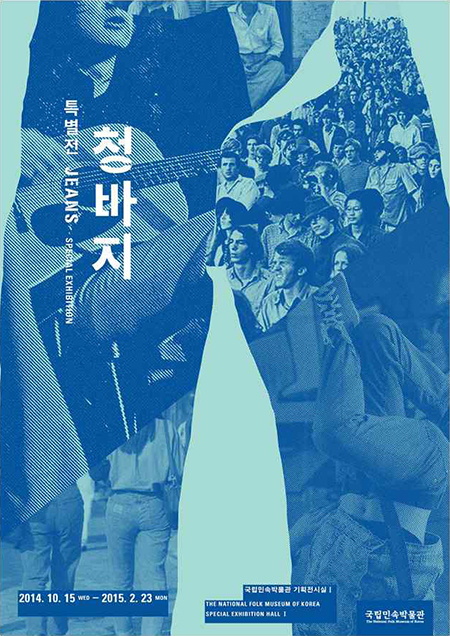
Jeans today are a common cultural element common to almost all mankind.
Over the years, jeans have been a symbol of challenge to authority, and of rebellion, of freedom. Today jeans have become casual clothing for contemporary people. Jeans have become one of the most democratic and widely-shared item that mankind has created. The popularity of jeans goes beyond such essentials as age, sex, status, nation, season and TPO (Time, Place and Occasion).
The National Folk Museum of Korea (NFMK) has researched the place of jeans in the culture of Korea and other countries since 2012. In general, jeans have two characteristics: a universal common item in life and a reflection of the specific era of each nation. In this special exhibition, we offer a look at jeans based on our research and our collection.
In chronological order, the exhibition presents first, the creation and proliferation of jeans in Western culture and, second, the culture of jeans in Korea as revealed in different kinds of jeans and in advertisements for jeans.
In addition, there is a film showing the history and meaning of jeans for iconic cultural figures, for people in the jeans industry, ordinary people in the street in Korea, and people met during two years of research overseas.
We hope that our visitors will understand that jeans are not just clothing for those of us who wear them, but that they are also cultural artifacts and a kind of window into the world in which we live in a wider sense.
Part I: The Creation and Proliferation of Jeans (Creation~1980)
The history of Jeans goes back 150 years in the U.S. Jeans were first created to fill the need for strong clothing for miners in the American west. Their origin thus was based in practicality. Later they become a symbol of freedom and rebellion in the 20th century. For instance, women wear jeans instead of skirts and men wear jeans to express a certain attitude. Jeans thus became a symbol of American ideas of equality and individual freedom.
Jeans first came to Korea at the time of the Korean War. The jeans worn by U.S. soldiers also became very popular among the younger generation of Koreans through seeing Western movies and being available on the market after the Korean War.
In 1970, jeans became the symbol of youth and rebellion, worn by the younger generation of Koreans to express ideas and values different from the older generation. Younger Koreans wore their jeans as part of creating a new culture. In the late 1970, jeans became very popular as outdoor clothing for Koreans of all generations
Attitudes about Jeans
Jeans cross times and space. People have various memories about jeans.
Let's listen to various people's voices as they talk about jeans: people who see jeans as an icon, jeans lovers, people who dislike jeans, and people who manufacture jeans.
In this film, you will see people expressing various opinions about jeans, as well advertisements for jeans, songs on the theme of jeans, and group photos. In addition, there is an art piece on the theme of jeans.
Part II: Jeans in Everyday Life (1980 ~ Present)
In 1980, jeans assumed a new role in popular culture, involving people of different ages and status, due to the growth of color TV, to the absence of curfews, and to a movement away from required uniforms for school students.
For teenagers in the 1980's, jeans no longer meant freedom or rebellion, especially as they became adults. Instead, they saw jeans as an expression of their identity and the character of their peer group.
Mixed Attitudes towards Jeans
World Views on Jeans
Jeans mean different things in different times and in different regions. NFMK and Daniel Miller, Professor at the University College London in the U.K., have carried out joint research since 2012 on the diversity of attitudes about jeans amongst people around the world.
Furthermore, we visited the Stiftung Levi Strauss Museum--the house of jeans' inventor Levi Strauss--in Buttenheim, Germany, as well as factories in San Francisco and Los Angeles, the birth places of jeans in the U.S. We also travelled to Kurashiki City, Okayama, in Japan, the home of Japanese jeans, and to the cities of Mumbai and Kannur in India, where there still exists a taboo about jeans as well as a fascination about them. Lastly, we went to London in the U.K. In this section of the exhibition, you will find stories from people whom we met while visiting those places.
Epilogue
There are no simple objects in the world. .Objects are made and used by human beings to reflect essential attitudes toward the world. Jeans are complex objects in this sense. We think of them as simple items of clothing to be worn, but they in fact tell complex stories about our views of the world and about the values of our societies.



